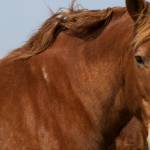Avoid Laminitis with Management Steps

Laminitis, the painful inflammation of the inner hoof tissues that lames so many horses, can strike virtually any horse under certain conditions. Horses that overeat carbohydrate-rich grain or grass, have been bedded on black walnut shavings, or have been forced to bear excessive weight on one limb are prime candidates, and most owners know to avoid these obvious risks.
Some classes of horses seem particularly susceptible to laminitis even if they are not exposed to the conditions above. These would include horses with Cushing’s disease,metabolic syndrome, or insulin resistance; mares that have retained their placentas after giving birth; and any horse that has survived a previous bout of laminitis.
To minimize the risk of laminitis in any horse, implement these management suggestions:
- For overweight or obese horses, limit grazing by using a drylot, grazing muzzle, or stall confinement for all but a couple of hours each day, preferably in early morning when sugars in grass are at their lowest levels. Cut out grain and feed a balancer pellet or vitamin-mineral supplement instead. Increase exercise gradually as tolerated to help the horse lose extra weight.
- For horses with metabolic diseases, follow the steps above. Check with a veterinarian to see if medications are indicated. Reduce carbohydrates in hay by soaking it in cold water for an hour before feeding. If you harvest your own hay, consider cutting it late at night or in the very early morning when it contains the lowest sugar levels.
- For all horses, use common sense in management. Follow a regular schedule of trimming/resetting shoes about every six weeks. Attend foalings and be sure the mare has not retained her placenta. Walk fields and fence lines regularly and remove debris that could cause hoof or sole injuries. Pay attention to the way the horse moves and have a veterinarian examine the horse if it seems stiff, short-strided, or unwilling to move freely, or if you feel unusual warmth when you touch the hooves. Feed several smaller meals of hay and grain each day rather than one large meal. Be certain that horses can’t gain access to stored feed or rich hay, and call a veterinarian immediately if a horse has accidentally consumed a large quantity of grain. Immediate veterinary intervention can often ward off a bout of laminitis, saving your horse from extreme pain and the potential for permanent disability.








